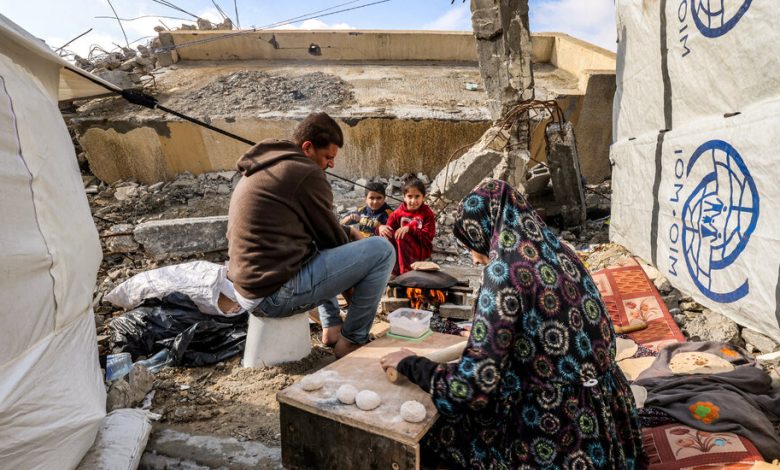What Happens When There Is No Food: Experts Say Severe Malnutrition Could Set in Swiftly in Gaza

A panel of experts affiliated with the United Nations has warned that the population of the Gaza Strip is at imminent risk of famine, with more than 90 percent of its 2.2 million people facing “acute food insecurity” and a quarter of the population experiencing “catastrophic levels of hunger.”
Even before the war between Israel and Hamas, nearly 70 percent of Gazans were dependent on humanitarian assistance for food because the territory has been under Israeli and Egyptian blockade since 2007. Now, only 20 to 30 percent of what people there need is being permitted over the border into Gaza, according to the World Food Program.The lack of electricity and fuel and the impossibility of moving around safely have compounded the challenges of producing food or getting it to people. Most people are going a day or longer without eating, the expert panel said.
As in a vast majority of other food crises the panel, the Famine Review Committee, has assessed in the 20 years since it was created, the situation in Gaza is not environmental but human-made. But Gaza is unusual for the speed with which people have been pushed into malnutrition.
In interviews, nutrition experts and doctors described what can happen when people can’t get food.
Children often fail first
Children, pregnant and lactating women, people with medical conditions and older adults typically succumb first to acute malnutrition. How long they can survive under conditions of extreme hunger will vary.
“It depends on the age of the person,” said Zita Weise Prinzo, senior nutritionist with the World Health Organization. “It depends on their health status. It depends on whether they have access to liquids, or to some sort of food, even if it doesn’t cover all the nutrient needs.”
UNICEF, the humanitarian aid organization that focuses on children, is particularly concerned about infants, said Anuradha Narayan, the agency’s senior adviser on child nutrition in emergencies. Before the war, about 60 percent of Gazan infants were formula-fed. Their families now have little or no access to any food supply for them.
“We know that there are many families who are probably unable to feed their children with infant formula,” she said.
For families who have found formula, the challenge is getting clean water to make it; an estimated 1.6 liters of drinking water (versus the minimum of 15 liters per day recommended by the W.H.O.) are available per person in Gaza now.
Progression to severe malnutrition is fast
Ms. Narayan said the agency estimated that 7,000 to 8,000 children are so severely malnourished that they are at risk of death without immediate treatment, but the active conflict in Gaza was making it difficult for aid agencies to evaluate the situation.
“We expect that those numbers can go up pretty dramatically in the next two to three weeks,” she said.
Ms. Narayan said that in her work in other food security crises, such as in Ethiopia, it was typical to see a child fall ill and progress to severe malnutrition and wasting within days.
For Gaza, she said, “It’s harder to predict but if there is nearly no food to feed young children, and illness involved, I would say it could be exactly the same. You go from being reasonably OK to being on some level of malnutrition, maybe not severely wasted, but still wasted, within a span of a few days. Particularly for the young, less than 2 years old, for sure that is likely to be the case.”
The trajectory for people with some access to food would be different, said Dr. Stanley Zlotkin, a professor of nutrition at the University of Toronto and an expert on the effects of critical food shortage. An adult may be able to survive for an extended period with only intermittent access to calories or with only foods that offer limited nutrients, he said. In a situation like Gaza’s, where there is still sporadic availability of some food, most adults would be able to survive for some time, but that would not be enough for children to prevent a progression to malnutrition.
What happens in the body
A malnourished body first burns fat reserves, said Heather Stobaugh, an expert on nutrition and emergencies with the aid agency Action Against Hunger, until those are depleted. Then, “The body will resort to using muscle, and eventually vital organs will begin to break down,” she said. “In the most severe forms of malnutrition, immune systems are weakened and vital organs actually start to shrink — the heart, lungs and so on.”
“When a child or an adult reaches this point,” she added, “their body is literally wasting away.”
Ms. Weise Prinzo said that people in this state minimize energy expenditure. “They stop any movement not necessary for immediate survival, but also within the organs, there are changes in how the heart and liver function,” she said. “They really try to manage, but eventually one or the other of the systems starts to fail.”
At this point, a starving person has a range of physical degradations, including extreme fatigue, an inability to regulate temperature and emotional impairment.
“We say ‘acute malnutrition’ andacute means that it could happen in a short period of time,” Dr. Stobaugh said. “It doesn’t always have to be months of a slow degradation.”
Malnutrition and disease drive a grim cycle
A malnourished person is vulnerable to disease because of a weakened immune system and because pf the conditions of conflict, where there is a lack of clean water and sanitation facilities, and people are often living in crowded shelters.
A malnourished body’s defenses — epithelial cells, which make up the surface of the skin and barrier tissues in places such as the gut — break down, and white blood cells malfunction.
“Then when you get sick, the body uses whatever protein and energy stores that you have, trying to fight the infection, and that cycle of infection and malnutrition is what rapidly causes the wasting to take place,” Ms. Narayan said. This process is more rapid in children, she said.
Dr. Zlotkin said disease spreads rapidly in situations such as the current one in Gaza, where 90 percent of people have been displaced and are sheltering in tents or other temporary structures, and there are few adequate latrines or washing facilities. Pneumonia and gastrointestinalinfections are the main causes of death for malnourished people.
“You have outbreaks of illness such as extreme diarrhea in combination with no health care services, no food, no clean water,” Dr. Stobaugh said. “This sort of perfect storm of adverse environmental conditions and health conditions is going to exacerbate the speed with which a body will become malnourished and can ultimately become on the brink of death quite quickly.”




